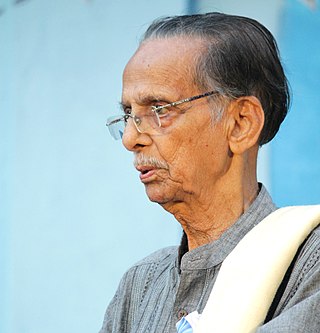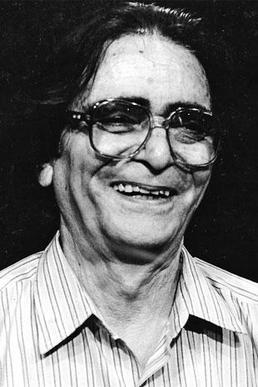Related Research Articles

The folk music of Uttarakhand refers to the traditional and contemporary songs of Kumaon and Garhwal regions in the foothills of Himalayas. This music has its root in nature and the hilly terrain of the region.

Kumaoni is an Indo-Aryan language spoken by over two million people of the Kumaon region of the state of Uttarakhand in northern India and parts of Doti region in Western Nepal. As per 1961 survey there were 1,030,254 Kumaoni speakers in India. The number of speakers increased to 2.2 million in 2011.

Narayan Shripad Rajhans, popularly known as Bal Gandharva, was a famous Marathi singer and stage actor. He was known for his roles as female characters in Marathi plays, since women were not allowed to act on stage during his time.

Girija Devi was an Indian classical singer of the Seniya and Banaras gharanas. She performed classical and light classical music and helped elevate the profile of thumri. She was dubbed as the 'Queen of Thumri' for her contribution in the genre. She died on 24 October 2017.
Kumudini Lakhia is an Indian Kathak dancer and choreographer based in Ahmedabad, Gujarat, where she founded Kadamb School of Dance and Music, an institute of Indian dance and music in 1967.

Komal Kothari (1929–2004) was an Indian folklorist and ethnomusicologist. Komal Kothari had devoted his life to investigation and documentation of folk traditions of western Rajasthan. Kothari received the honour of Padma Shri and Padma Bhushan from the Government of India. Komal Kothari painstakingly worked to preserve the cultural memory and made numerous recordings of folk music. He studied Langa and Manganiyar communities of folk musicians of Thar desert. Komal Kothari was not only a scholar but also a man of action. He co-founded Rupayan Sansthan - Rajasthan Institute of Folklore, in 1960 in the village of Borunda. The institution houses a repository of recordings by Kothari and works to collect, preserve, and disseminate the oral traditions of Rajasthan. Kothari was co-editor of the journal Lok Sanskriti, a journal based on the theme of folk culture. Besides, Kothari arranged international performances of folk artists from Rajasthan in several countries. His monograph on Langas, a folk-musician caste in Rajasthan, was enlivened by an accompanying album of recordings of twelve folk songs sung by Langa artistes. His understanding of desert culture and its connections with ecology endeared him to the environmentalists. He planned a museum based on the ecology of the broom’, to show the technical use of specific types of desert grass for specific purposes. His vision was actualised in the form of Arna Jharna - The Thar Desert Museum of Rajasthan in Borunda, near Jodhpur. Kothari was a scholar of patterns of culture and his expertise enriched both folklore studies and history.

Kavalam Narayana Panikkar was an Indian dramatist, theatre director, and poet. He has written over 26 Malayalam plays, many adapted from classical Sanskrit drama and Shakespeare, notably Kalidasa's Vikramorvasiyam, Shakuntalam (1982), Bhasa's Madhyamavyayogam (1979), Karnabharam, Uru Bhangam (1988), Swapnavasavadattam, and Dootavakyam (1996). He was the founder – director of theatre troupe, Sopanam, which led to the foundation of Bhashabharati: Centre for Performing Arts, Training and Research, in Trivandrum.

Mohan Upreti (1928–1997) was an Indian theatre director, playwright and a music composer, considered one of the pioneers in Indian theatre music.
Pandit Shambhu Maharaj was a Guru of the Lucknow Gharana (school) of the Indian classical dance form, Kathak..Padma Shree Award -1958 Sangeet Natak Academic Award -1967
Brij Mohan Shah (1933–1998), better known as B M Shah, was an Indian theatre director and playwright. Shah along with Mohan Upreti, are together credited for the revival of the theatre in the Uttarakhand. He was awarded the Sangeet Natak Akademi Award in 1979.
The Katyuri kings were a medieval Hindu ruling clan of Rajput origin that ruled over the regions in Uttarakhand in India and western Nepal from 700 to 1200 CE. The founder of this dynasty, King Vasu Dev was originally a Buddhist ruler, but later he started following Hindu practices sometimes attributed to a vigorous campaign of Hindu philosopher Adi Shankara.
Bedu Pako Baro Masa is a Kumaoni folk song in Kumaoni language which was composed by Mohan Upreti, B. M. Shah and written by Brijendra Lal Shah. This Kumaoni song was composed, written and first performed in the early 1950s and since has become popular all over Uttarakhand as even before it had been sung as a traditional folk song among the villagers in Kumaon. This song is the official regiment song of the Kumaon Regiment of Indian Army.
Gangadhar Pradhan was an Indian Odissi dancer.
Nataraja Ramakrishna was an Indian dance guru. He was the chairman of Andhra Pradesh Sangeeta Nataka Academy. He was also a scholar and musicologist who promoted classical dance in Andhra Pradesh and worldwide.

Shanno Khurana is an Indian classical vocalist and composer, from the Rampur-Sahaswan gharana of Hindustani classical music. A disciple of the doyen of the gharana, Ustad Mushtaq Hussain Khan, she is known for performing rare bandish and raag, though her singing style includes genres like khayal, tarana, thumri, dadra, tappa, to chaiti and bhajan. Born and brought up in Jodhpur, she started singing on All India Radio in 1945 in Lahore, later shifted to Delhi, where she continued her singing on All India Radio, Delhi and in concerts and music festivals. She also pursued music education, finally earning her M.Phil. and PhD in music from the Kairagarh University, and has undertakes extensive research on folk music of Rajasthan.
Gambhari Devi was a veteran Indian folk singer, folklorist and dancer from Bilaspur district, Himachal Pradesh, noted for her contribution to the folk culture of Himachal Pradesh.
Madras Kadiravelu Saroja, was an Indian classical dancer, known for her expertise, as an exponent and as a teacher, in the classical dance form of Bharatanatyam. The Government of India honored her, in 2011, with the Padma Shri, the fourth highest civilian award, for her services to the field of art and culture.

Naima Khan Upreti was an Indian theatre actor, singer and a producer at Doordarshan. She was also the wife of Mohan Upreti, considered to be one of the pioneers in Indian theatre music.

Kumcha Lempi, also known as Kumja Lembi, is a woman in Meitei mythology and folklore of ancient Kangleipak. She is known for being a victim of an attack by a tiger in Khoirentak. Her tragedy is frequently mentioned, narrated and retold in the Moirang Kangleirol legends, usually by the Pena playing balladeers till present times.
References
- ↑ Fiol, Stefan (2017-09-11). Recasting Folk in the Himalayas: Indian Music, Media, and Social Mobility. University of Illinois Press. ISBN 978-0-252-09978-6.
- ↑ Ramaswamy, Vijaya (2003). Re-searching Indian Women. Manohar. ISBN 978-81-7304-496-0.
- 1 2 Agarwal, Deepa (2012-08-07). Rajula and the Web of Danger. Hachette India. ISBN 978-93-5009-464-8.
- ↑ Upreti, Mohan (1980). Malushahi: The Ballad of Kumaon. Sangeet Natak Akademi.